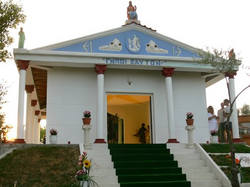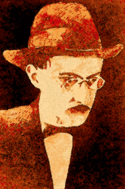Sigurblót 2009
The woman to the left in red with her arms folded is Jóhanna Harðardóttir, Kjalnesingagoði (Goði (priest) of Kjalarnes). The man on her right is Árni Einarsson, another goði. He is holding a book in preparation for chanting verses from the Poetic Edda. The man in the center of the picture wearing white and green is Hilmar Örn Hilmarsson, allsherjargoði (Common Chieftain or High Priest). He is holding a drinking horn and a ceremonial ring. The ring is used for sanctifying the ceremony while the horn is used for libations to the gods and ceremonial communal drinking. Towards the bottom right is a ceremonial fire.
The weather was mild but rainy, two participants can be seen with an umbrella. The clergy are wearing ceremonial robes while other participants wear everyday clothing. Not seen in this picture are the 50 or so participants standing in a semi-circle around the clergy. Those included a boy, probably 13 years old, about to undergo a simple coming-of-age ceremony.Relevante Bilder
Relevante Artikel
NeopaganismusNeopaganismus oder Neuheidentum bezeichnet seit dem 19. Jahrhundert aufgekommene religiöse und kulturelle Strömungen, die sich vor allem an antikem, keltischem, germanischem und slawischem Heidentum sowie an außereuropäischen ethnischen Religionen orientieren. .. weiterlesen








